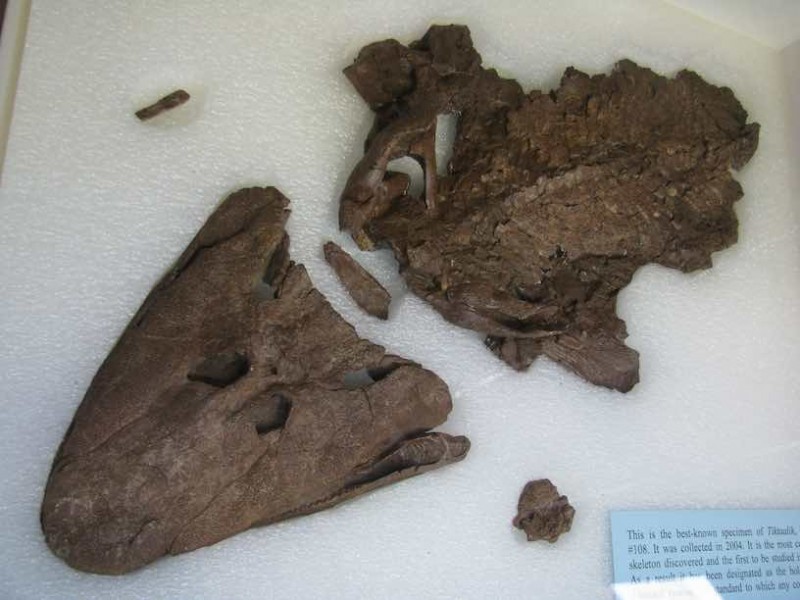In 2006 scientists euphorically reported the 2004 discovery three-quarters of a fossilized fish under the ice in arctic Canada they named Tiktaalik roseae. It was hailed as convincing proof that fish sprouted legs, then walked on land to became amphibians, mammals, and eventually people. It was a slimy assertion from the start yet continues to be held up as prima facia evidence of evolution. Similar to other lobe-finned fish like the coelacanth we wrote about last week, it was discovered in the same Devonian rock layer and thus dated at 375 million years, making its age highly suspect. What’s the big reason they believe it’s a transitional fossil? It has wrist bones and might have been able to breathe oxygen out of water.
 These are hardly unique features. Even today, we have all sorts of animals still classified as fish that can breathe air and walk. For instance, the northern snakehead and the walking catfish are air-breathing fish that can travel overland a considerable way. Mudskippers breathe oxygen through their skin and skip along land. There’s even a climbing perch that can breathe air, walk on land and even climb trees. Though living in plain sight, evolutionists don’t consider them as tetrapod ancestors, just interesting and specialized fish. But Tiktaalik is extinct, so he must have sacrificed his heritage to become an amphibian. [1] All this from a small fossil (see photo, right)! [2]
These are hardly unique features. Even today, we have all sorts of animals still classified as fish that can breathe air and walk. For instance, the northern snakehead and the walking catfish are air-breathing fish that can travel overland a considerable way. Mudskippers breathe oxygen through their skin and skip along land. There’s even a climbing perch that can breathe air, walk on land and even climb trees. Though living in plain sight, evolutionists don’t consider them as tetrapod ancestors, just interesting and specialized fish. But Tiktaalik is extinct, so he must have sacrificed his heritage to become an amphibian. [1] All this from a small fossil (see photo, right)! [2]
One reason such conjectures sway men’s opinion is because of their cornerstone evolutionary doctrine, namely “homology”. The Concise Oxford Dictionary of Zoology defines homology as “the fundamental similarity of a particular structure in different organisms, which is assumed to be due to descent from a common ancestor” (italics, mine). As any engineer will tell you, high-performance machines don’t just ooze up out of the ground. Common features are signs of a good common design, not common ancestors (see below).

Though the amphibious vehicle (L) and the M1 Abrams (R) both use tracked wheels, they don't come from a common ancestor; in fact, they were made in two different countries. Tracked wheels are just a good design. (WikiMedia)
Frankly, there’s not a lot of homology in Tiktaalik anyway. Frank Sherwin of ICR observes that “the bones in Tiktaalik’s fins have no axial skeleton connections. This is significant because without this direct connection, no true walking could be done by Tiktaalik. Furthermore, the fins of this creature enclose rays, not digits such as toes or fingers.” [3] Further examination only highlights more critical differences. Tiktaalik has a narrow pelvis and boasts well-developed gills - so it’s still considered a fish. All tetrapods need a rear wide pelvis and strong bones bracing the legs to support their weight on land, which is just the opposite of Tiktaalik.
This fish story was fried when some tetrapod tracks were found in rock layers dated 18 million years older. It seems something else was walking around long before him. Mr. Sherwin sums it up nicely: “According to the creation science model, these fossil tracks were formed along with most fossils during the single year of Noah’s flood. … Tiktaalik needs to be removed from textbooks and museum displays where it is currently positioned as a creature with key transitional features. The evolutionary story of how fish sprouted limbs just went back to square one. The slate is blank, and it can either be filled in with a new speculative story about how sea life moved onto land—or with a new paradigm altogether.” [4] How about this: Thou art worthy, O Lord, to receive glory and honour and power: for Thou hast created all things, and for Thy pleasure they are and were created.
[1] Answers In Genesis, Tiktaalik and the Fishy Story of Walking Fish, 2007
[3] Frank Sherwin, Institute for Creation Research, Tiktaalik Our Ancestor?, 2006
[4] Frank Sherwin, ICR, Banner Fossil for Evolution Demoted, 2010
Like this? Consider sharing it to Facebook by clicking the linked icon below.
